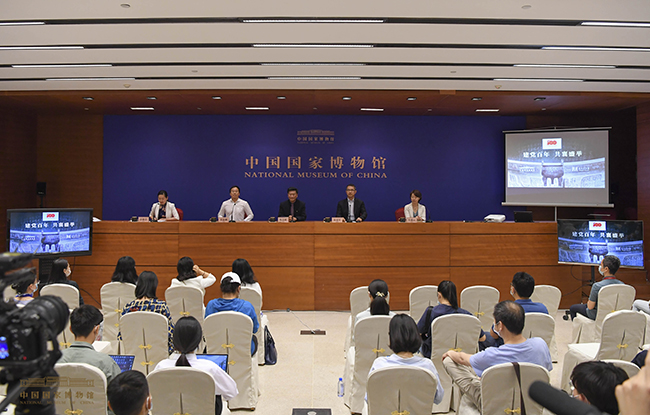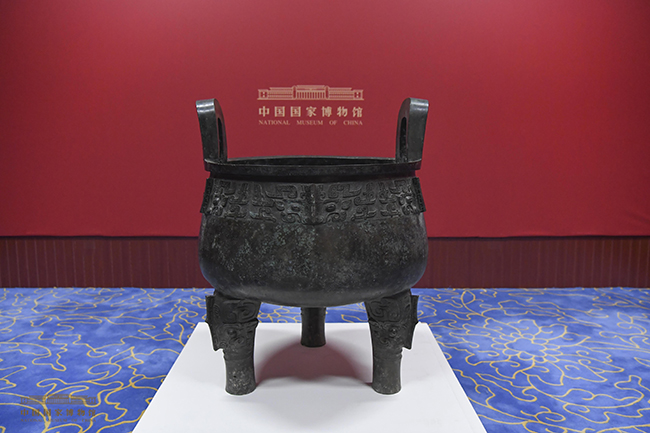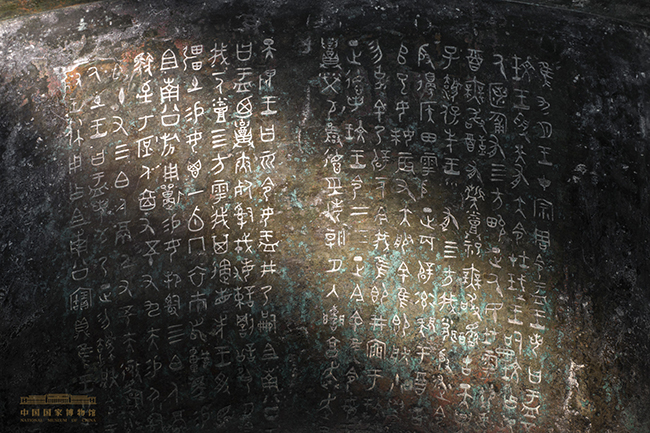
As a tribute to the centenary of the Communist Party of China, the National Museum of China and the Shanghai Museum will jointly promote special exhibitions of the Da Yu Ding and Da Ke Ding to be held successively at the two museums, as well as carry out in-depth cooperation in the fields of seminars, publicity and education, and cultural and creative products.
On June 10, 2021, a press conference titled “Jointly Undertaking Great Initiatives to Celebrate the 100th Anniversary of the Founding of the Communist Party of China” was jointly held by the National Museum of China and the Shanghai Museum. Chen Chengjun, executive deputy director of the National Museum of China, Yang Zhigang, director of the Shanghai Museum, Hu Jialin, associate researcher of the Bronze Research Department of the Shanghai Museum, and Zhu Xiaoyun, general manager of NMC (Beijing) Cultural Industry Development Co., Ltd., attended the conference and answered questions from reporters.

Bronze ding vessels were traditionally symbols of the state, while those with inscriptions were used to teach future generations the virtues of their ancestors. The Da Yu Ding dates back to the Western Zhou Dynasty during King Kang’s reign, and the Da Ke Ding is from the time of King Xiao’s reign. Both inscriptions are important resources for studying the politics and economy of Western Zhou society. In 1951, the Da Yu Ding and Da Ke Ding were donated to the state by Pan Dayu, and in 1959, the Da Yu Ding was collected in the National Museum of Chinese History (today’s National Museum of China). Whether in the “General History of China” exhibition at the former National Museum of Chinese History or the “Ancient China” and “Ancient Chinese Bronze Art” exhibitions at the National Museum of China today, the Da Yu Ding has always been “shown for the people” in important exhibitions. This is a practical way to not only achieve the mission of the National Museum of China but also fulfil Pan’s wish of “making national cultural relics available in important areas of the country for the public to visit and study,” as she expressed when donating the relics.
Chen Chengjun, executive deputy director of the National Museum of China, said the mutual loan of the Da Yu Ding and Da Ke Ding between the National Museum of China and the Shanghai Museum, and the planning of their respective special exhibitions based on these two national treasures on the occasion of the 100th anniversary of the founding of the Communist Party of China, is an affectionate tribute from the museum community to the Party’s centenary. It is also an important practice of the principle of “putting exhibitions before collections and seeking mutual benefit through open cooperation.” It is believed that the exchange and cooperation between the two museums will further bring cultural relics to life and promote the prosperity of China’s cultural and museum industry in the new era.
Yang Zhigang, director of the Shanghai Museum, said the opening ceremony of “The Perpetual Prosperity: Special Exhibition of Donated Ding Vessels to the Shanghai Museum” will be held on June 18, 2021. This special exhibition will last for one month. The bronze ding exhibited were donated by people from all walks of life. The Da Yu Ding and Da Ke Ding donated by the Pan family will be reunited at the Shanghai Museum. The story of these two national treasures can be regarded as one of the most beautiful and magnificent poems in the world of Chinese cultural relics, reflecting the patriotism of the collector and her enthusiasm for cultural inheritance. In order to coordinate the mutual special exhibitions of the Da Yu Ding and Da Ke Ding, the Shanghai Museum will hold a seminar on ancient Chinese bronze culture in July 2021.
Zhu Fenghan, former executive deputy director of the National Museum of China and renowned expert on ancient bronzes, introduced the history, culture and artistic value of the Da Yu Ding to the press at the conference via a recorded video message. Zhu Xiaoyun, general manager of NMC (Beijing) Cultural Industry Development Co., Ltd., said the mutual special exhibitions of the Da Yu Ding and Da Ke Ding are of great significance, and aim to take fleeting moments in history and enshrine them in eternity through cultural and creative products. Hu Jialin, associate researcher of the Bronze Research Department of the Shanghai Museum, introduced information related to the Da Ke Ding.
The National Museum of China and the Shanghai Museum will also jointly launch a series of promotional activities, including in-depth reports, live broadcasts of the exhibitions, short videos of cultural relics, and related creative products. The exhibitions aim to interpret ancient Chinese art and outstanding Chinese traditional culture from multiple perspectives and strengthen the nation’s cultural identity and cultural confidence.
